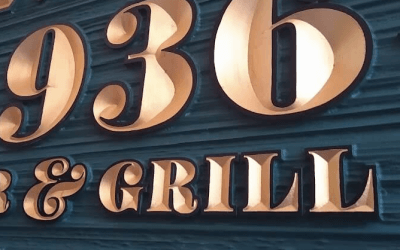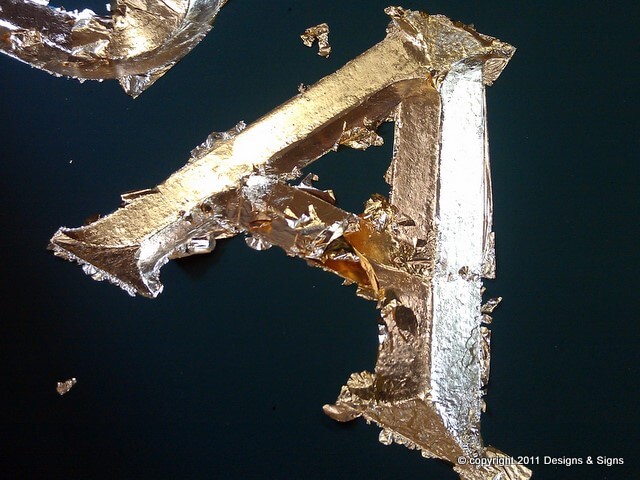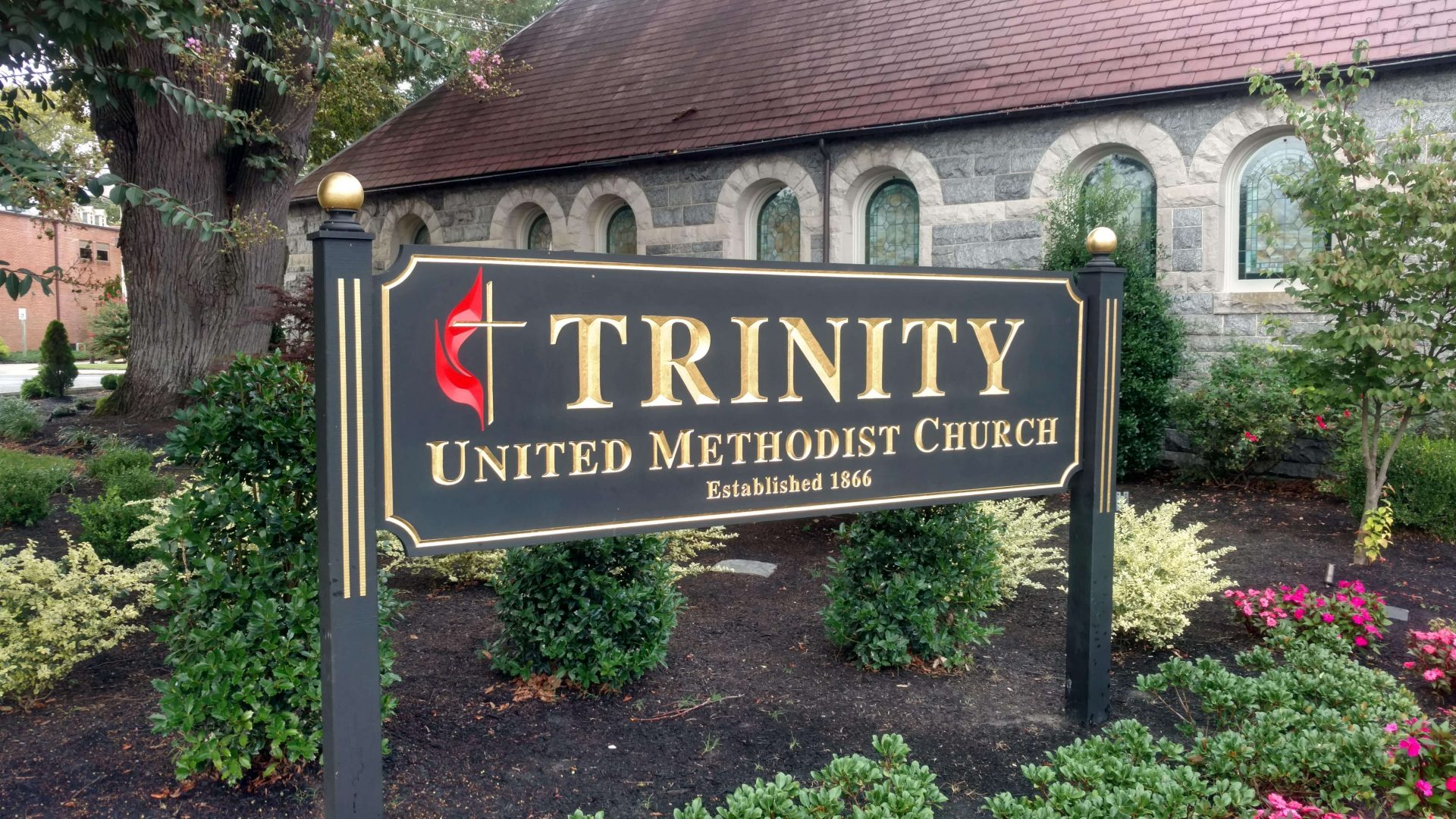Making the neighborhood sign
Attractive Neighborhood signs are in high demand. Often, we make them with HDU (High-Density-Urethane) due to their relatively lightweight and durability. Designs & Signs completed this particular sign for Esquire Association Management, LLC. We installed it at the Eagles Crossing community in Mechanicsburg, Pennsylvania. The construction of these types of neighborhood signs involves a lengthy multi-step process.
In the beginning, we used a CNC router to carve the sign’s face with woodgrain and the name and eagle logo. Once completed, the entire sign needed to be primed and painted by hand. Next, it was time for gold leaf. The beginning of this stage required that all flat surfaces receive a careful application of gold size, which enables the gold leaf to adhere to the substrate correctly. After allowing the gold size to set up, we could finally begin applying the gold leaf. Due to the large size of this sign, even a single letter required multiple sheets of gold leaf. Once we had covered all flat surfaces with gold, then we could delicately brush away the excess. Touch-up paint is sometimes needed around the sign’s face to hide any gold leaf flakes that stick to the background.
Building the neighborhood sign frame
Now that We completed the sign, we were finally able to begin construction of the frame. First, the frame posts needed to be cut to the same length and then routed. As shown in the photos, the posts were painted the same color as the sign for continuity. In addition, we painted the structural cross-members behind the sign face to match.
Of course, no post is complete without a decorative cap. Therefore, the trim on these post caps was painted white. However, to match the gold leaf on the sign, we also covered the top of each cap in gold leaf. Of note, other sign details include two white vertical stripes, which we painted onto each post using a stencil.
Installing neighborhood signs with steel and concrete
We place each post in the ground with steel legs. The legs go at least 30 inches deep. Using this two-part leg construction also makes the sign easier to transport. When we arrive at the location, first we dig and leave the holes, then we use stainless steel 3-inch lags to attached the pre-drilled steel legs to the bottom of each post. Each post has two opposing legs. We attach each leg with 4 lags. After placing the sign into the ground, we fill the holes each with at least one hundred pounds of concrete. We are sure to maintain the level of the sign as the concretes hardens. This approach to sign installation prevents the posts from splitting because of ground water. Because of this, our signs always last longer!
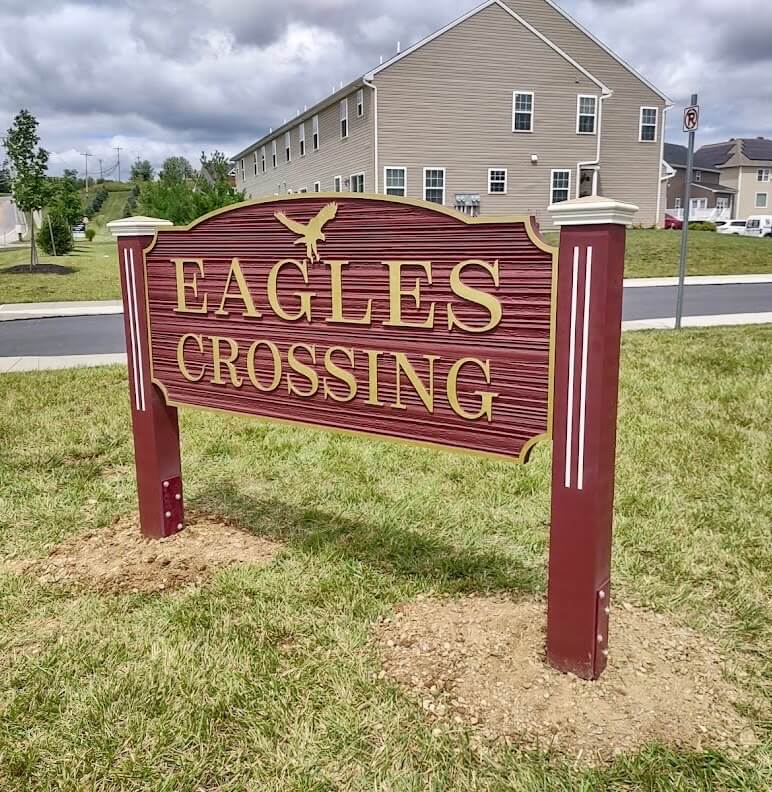
Shown above is the Eagles Crossing neighborhood sign just after We installed it. Digging the post holes was difficult due to the number of buried rocks from the community development. Landscapers will also replace the gravel around the posts with mulch and flowers for an aesthetic appearance.

Shown in this photo are the steel footers we attached to the posts. Steel footers add durability while removing the possibility of the posts decaying underground over time. The footers are each placed 30 inches deep in the soil and anchored with concrete for a steadfast placement.
History of Mechanicsburg, PA
Located in Cumberland County, this city lies in a rich agricultural region known as the Cumberland Valley. In the early 19th century, Mechanicsburg was a settlement of mechanics that made and repaired Conestoga wagons. Its continued growth was also attributable to the Cumberland Valley Railroad (CVRR). In 1837, once Mechanicsburg’s line was complete, it was designated a water station where workers could refill the locomotive’s wood and pump water. At one point, 25 trains travel through Mechanicsburg daily carrying travelers and valuable resources like coal, feathers, fruit, ice, mail , and newspapers. During the Civil War, the railroad was an invaluable method of transporting troops and supplies. In 1862, residents saw the first evidence of the Civil War when Confederate prisoners passed through Mechanicsburg on the CVRR.
Before becoming incorporated on April 12, 1828, Mechanicsburg had different names throughout its history. Initially, residents called it Drytown due to the extreme water scarcity during both winter and summer. Next, it was known as Pinchgut, a German name used as amusement, given to a small village of only a few people. Finally, some people called it Taufferstown to honor Henry Stauffer, who owned much of the land in the center of town. Also briefly referred to as Creekville during the Colonial Era, Mechanicsburg is home to many historical markers, such as the Irving Female College (named for Washington Irving, a trustee), the first women’s college in Pennsylvania grant degrees in arts and sciences.
Mechanicsburg, PA today
Today, Mechanicsburg is home to numerous events, including the Art Walk & Wine Tasting, Earth Day Festival, and Jubilee Day – the East Coast’s most prominent, one-day street fair. Mechanicsburg also delights history buffs, brimming with old Pennsylvania charms like railroad sights and preserved buildings. In addition, this historic town offers local shopping, dining, a theater, and a farmer’s market. Mechanicsburg’s dining options include ethnic cuisine like Thai, Indian, and more and familiar chain restaurants and local establishments that are worth a visit.
- https://www.visitcumberlandvalley.com/towns/mechanicsburg/
- https://www.visitpa.com/region/dutch-country-roads/mechanicsburg
- https://en.wikipedia.org/wiki/Mechanicsburg,_Pennsylvania
To learn more about Esquire Association Management LLC, please visit the links below.
- https://esqmanagement.com/
- https://www.facebook.com/Esquire-Association-Management-LLC-324488677690407/
- https://twitter.com/esqassocmgmt
- https://www.instagram.com/esqassocmgmt/
